Korfball drills for technique condition / strength
- At trainer's signal, both players start sprinting.
- Blue must run around first pawn and Red runs straight through to tap Blue.
- Red becomes Blue and flips over.
Objective:
The base is a standard running form exercise, where you have players move back and forth in different ways to train general motor skills.
The tap game element adds responsiveness by having players react as quickly as possible and determine what they are going to do.
The tap game element adds responsiveness by having players react as quickly as possible and determine what they are going to do.
Description:
- The players stand on a line and are given a way by the trainer to run across each time, see also running forms.
- All players have a ribbon on, 1-3 players with the same color.
Occasionally, while walking back and forth, the trainer calls out the color of 1 of the ribbons. These then become the tickers. The tickers get 10 seconds to tap as many of the remaining players as possible. - Then all return to the same line and start a running form again.
- The idea is to start the tagging round immediately when the trainer calls a color and to quickly start the next running form when the tagging round is over. Keep up the pace.
Variations:
Instead of running forms where players walk back and forth, you can do movement exercises standing in the same spot. Examples include Jumping Jacks, sitting/lying and getting up again, jumping forward and backward, etc.
The trainer occasionally gives the next movement assignment and calls a color to start a tap round.
Running Forms:
Standard
- Running / Running backwards
- Hopping / Hopping backwards
- Sideways with front right / Sideways with front left
- Small steps
- Hopping on right / Hopping on left
- Cross pass
Jumps
- Jumps as large as possible.
- Medium-sized jumps and always balancing on 1 foot for a while before taking the next jump.
- With two feet side by side.
- With two feet side by side a big jump forward and another small jump back.
- With two feet zigzagging.
Arm movements to be combined with the above forms.
- Swing 1 arm forward or backward.
- Swing both arms forward, or both backward.
- 1 arm forward and 1 arm backward.
- Holding another body part with 1 or both arms.
As animals
- Frog; jumping on hands and feet.
- Crab; on hands and feet, with belly up.
- Kangaroo; jumping on two legs.
- Flamingo; hopping.
- Duck; crouching walk.
The trainer occasionally gives the next movement assignment and calls a color to start a tap round.
Running Forms:
Standard
- Running / Running backwards
- Hopping / Hopping backwards
- Sideways with front right / Sideways with front left
- Small steps
- Hopping on right / Hopping on left
- Cross pass
Jumps
- Jumps as large as possible.
- Medium-sized jumps and always balancing on 1 foot for a while before taking the next jump.
- With two feet side by side.
- With two feet side by side a big jump forward and another small jump back.
- With two feet zigzagging.
Arm movements to be combined with the above forms.
- Swing 1 arm forward or backward.
- Swing both arms forward, or both backward.
- 1 arm forward and 1 arm backward.
- Holding another body part with 1 or both arms.
As animals
- Frog; jumping on hands and feet.
- Crab; on hands and feet, with belly up.
- Kangaroo; jumping on two legs.
- Flamingo; hopping.
- Duck; crouching walk.
Jumping exercise with 9 cones.
- You sprint back and forth between 2 cones.
- 30 seconds
- 15 seconds rest
- 30 seconds
- 30 seconds rest
- 30 seconds
- Then take penalty throw directly
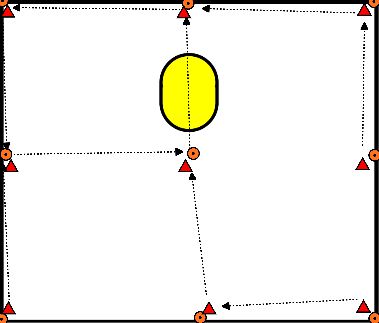
Exercises with speed ladder: agility and coordination exercises. Each exercise 4x
The intention is also to emphasize balance. So use your arms as well.
The intention is also to emphasize balance. So use your arms as well.
- 2 foot contacts per section forward.
- 2 foot contacts per square sideways (only in the ladder).
- Icky shuffle (in-out).
- Icky shuffle backwards.
- In and out (2 feet in, 2 feet spread out from the ladder) explosively.
- 1 foot in-out: start next to the ladder, always in and out, other foot stays out of the ladder in a nice rhythm.
- Sideways in-out the ladder 2 foot contacts.
- Cross-over: move sideways, always bring the 'back' leg in front.
- Sideways through the ladder, changing foot each time you jump.
- Reverse cross-over: about the same as icky-shuffle, but always bring the outer foot back through the ladder.
- Carioca: lateral through the ladder, front to back.
- Like icky-shuffle, but with 2 feet together (out-in-out).
- Same as previous, but now on 1 leg.
- 2 foot contacts per compartment, 2 compartments in front, 1 compartment back.
- 3 pawns in front of the basket (fixed declarer).
- 1 rebound, 1 attacker.
- Attacker starts at the back pawn.
- When you score a goal, you may move one pawn forward.
- When you miss, you move one pawn backwards.
- Fixed declarer, change after one round.
- Rounds of play:
- Round 1:
- 10 loose balls.
- Round 2:
- 8 short chances.
- Round 3:
- 5 shots. (3m, swerve alternately).
- Round 4:
- 4 shots. (5m, changeable evasion) Good for 2 points.
- Final:
- Score 25 short chances (together).
- Couple with most points wins.
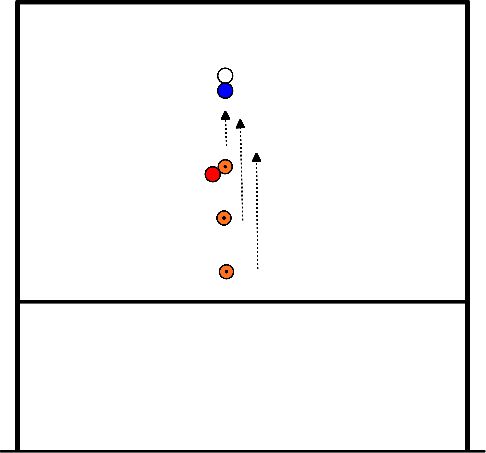
- Conditioning game 2 teams - 5 rounds.
- You stay with your teams on your own side.
- Handlers change sides to keep everyone moving.
- The aim is to do the exercise with high intensity.
- Start in front of the pawns. After pion 5 in sprint to the first basket.
- Rebound sprints to the second basket.
- Rebounder second basket joins again with the pawns.
- Individual scorer count up.
- Counting out loud with your team.
- Per round 1 point.
- Round 5 = 2 points.
- Round 1:
- 10 balls. (pawn exercises = knee lifts)
- Round 2:
- 8 shots 3-4m. (Pawn exercise = 2 pawns forward, 1 pawn backward)
- Round 3:
- 10 short chances. (pawn exercise = zigzagging)
- Round 4:
- 6 shots 4-5m. (pawn exercise = zigzagging backwards)
- Round 5:
- Team with least points determines exercise, also the pawn exercise.
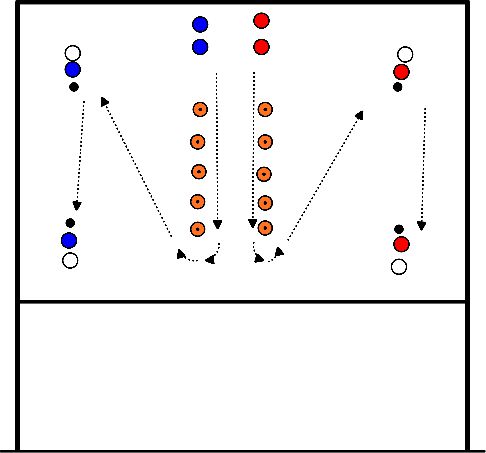
- Round 1:
- White throws to blue, gets the ball back, throws to red (blue is going towards the basket), gets the ball back, throws at blue for walkthrough.
- Blue catches and starts the exercise again by throwing to red. (10x scoring)
- Round 2:
- Same as round 1 but blue passes to white for a short chance. (10x scoring)
- Round 3:
- Ditto round 1 but blue deflects for shot at 4m. (6x scoring)
- Round 4:
- Ditto round 3 but white pulls away from rebound for short chance (10x scoring)
- Round 5:
- White throws to blue, gets the ball back, throws to red (blue is going towards the basket), white doubles up with red and runs a deep line, gets the ball and shoots (6x scoring)
- Round 6:
- Ditto round 5 but white does not shoot and passes to red who connects and red shoots. (6x scoring)
- At high intensity, good condition training.
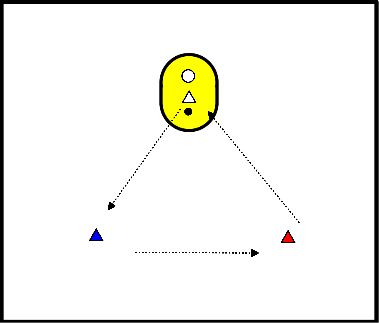
- Try to bounce through 'the forest' without the 'trees' knocking the ball away with their 'branches', then score in the baskets behind the forest.
- Who has scored the most goals?
- Step 1:
- You may occasionally grip the ball with two hands.
- Step 2:
- You may occasionally bounce the ball with 2 hands.
- Step 3:
- You must do everything with one hand.
Rules:
- A runner may not hold the ball in 2 hands, but must bounce with 1 hand.
- A runner must stay within the lines or the forest.
- If the ball is tapped away from the runner, the runner will start over again.
- Make sure the children don't have to wait.
- Several runners start at the same time!
- If the runner manages to get out of the forest, the runner can:
- Step 1:
- Shoot at the cor until a score is scored.
- Step 2:
- Max. 1 shot.
- The 'tree' stays completely in the hoop or with one leg.
- Choice of the trainer.
- The 'tree' can tap the ball away with 2 hands or with one hand on the back.
- Choice of the trainer.
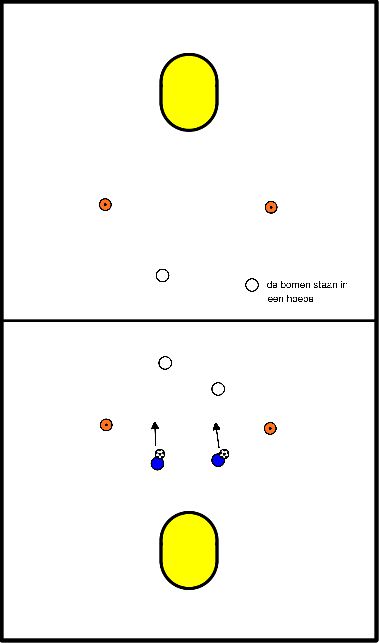
Task:
- Who is the first to circle the ball or the player?
Rules:
- Everyone stands in a circle with enough space to throw a ball quickly.
- The ball starts to the right of the child who is going to run.
- The child who is going to run, runs at the same time as throwing the first ball on the outside of the circle.
- Play 2:2, which pair scores 5 goals first. (We do this 2 times against another pair).
- 4:4, where in a small space 10x must be played over, without the ball being intercepted or dropped.
- If this exercise is too easy, you can play the ball within 4 seconds.
- The most important thing in this exercise is that the players run free, complete in time and keep an overview.
- This is an exercise in which you can increase the understanding of running free
- Especially if you speed up the game. (which team will score first 3 times)
- Each player a hoop and a pawn.
- Player puts the pawn about 5 metres from the hoop.
- Player turns the hoop and sprints to the pawn.
- Player must be back before the hoop is finished.
- If successful, move the pawn one metre away.
- Who can achieve the greatest distance?
(On the zero 23 site there are corresponding instructional videos)
2 speed ladders, basket behind them, after each exercise walk through for a walkthrough or a shot, catch your own ball and pass to the next player.
- Lateral high knees, speed ladder:
- Jog sideways through the ladder, lifting your knees up and keeping your torso straight.
- Move your arms along with the movement.
- Lateral fast feet, speed ladder:
- Move sideways through the ladder at a high pace, moving your arms with you.
- Lateral ali shuffle, speed ladder:
- Stand in front of the speed ladder and do staggered jumps, keeping one leg in the ladder at a time.
- Lateral ali shuffle hip twist, speed ladder:
- Stand in front of the speed ladder and do staggered jumps with one leg at a time, rotating the hip with the speed ladder.
- Forward high knees, speed ladder:
- Stand in front of the speed ladder and walk at a dribbling pace through the (speed) ladder.
- Raise your knees and keep your torso upright.
- Forward squat in out, speed ladder:
- Stand in front of the speed ladder and jump two feet into the ladder, then jump right back out and end up in a squat position.
- Make sure your thighs are horizontal and your torso is upright.
- Forward o uchi gari, speed ladder:
- Stand in the speed ladder placing one foot outside the ladder and one foot inside the ladder.
- Move the foot inside the ladder one step at a time and bring the foot outside the ladder from front to back.
- Forward in-in out, speed ladder:
- Stand in front of the speed ladder and step into the ladder, always placing one foot inside the ladder and always placing one foot outside the ladder.
- Forward fastfeet, speed ladder:
- Stand in front of the speed ladder and walk through the (speed) ladder at a fast pace.
- Forward in-in,out-out, speed ladder:
- Stand in front of the speed ladder, stepping two feet in first, alternating with two feet outside the ladder.
- Backward in-in, out-out, speed ladder:
- Stand in front of the speed ladder with your back to it and step backwards, first with two feet on the ladder and then with two feet outside the ladder.







